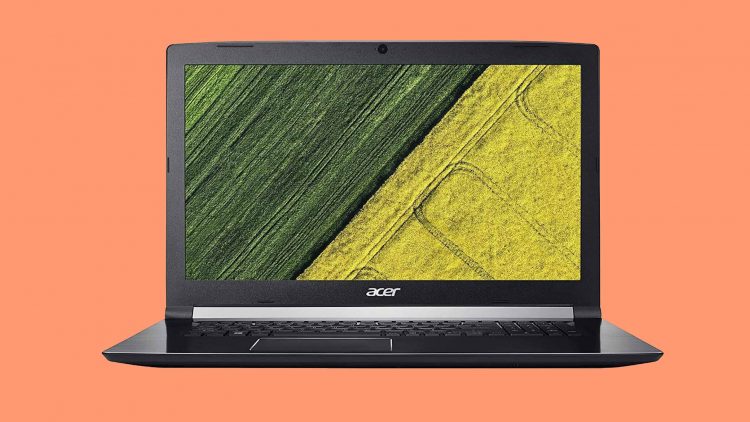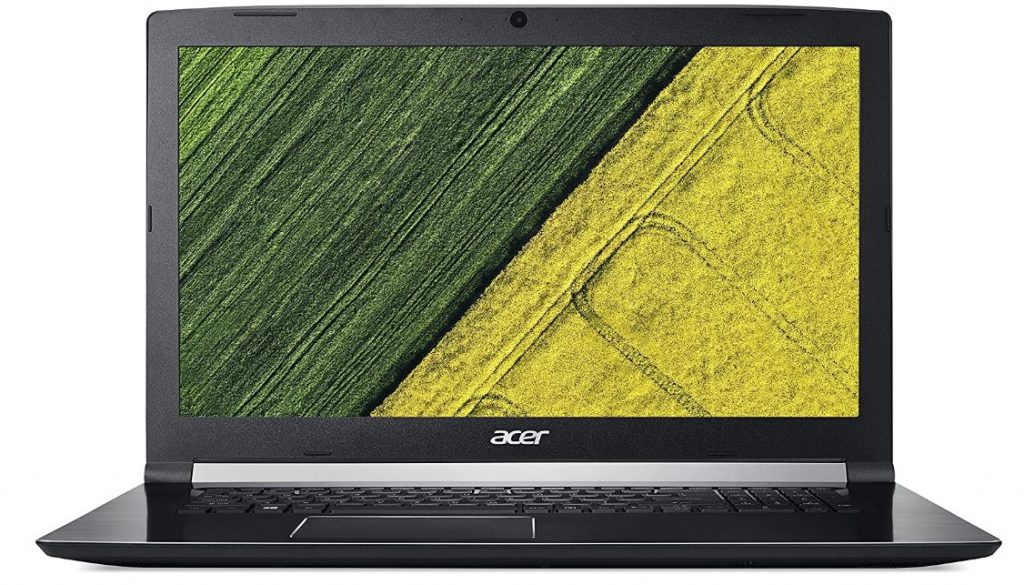Even the most challenging tasks may be carried out quickly and constantly with the new Acer Aspire 7 A717-72G 700J. With its Intel processor and NVIDIA GeForce GTX 1060 graphics, this robust computer again gives you the capability to complete even the most demanding tasks.
It offers a magnificent 17.3-inch Full HD IPS screen that brilliantly reflects light, excellent performance you can count on.
In addition, the most modern WiFi connections, are all packaged inside a slim, portable design that’s easy to fit in a bag and bring to class.
You can take care of your social media accounts, rapidly browse the web, and catch up on your assignments using this laptop.
Acer Aspire 7 a717-72g Laptop Review
Specifications:
| Brand | Acer |
| Series | Aspire 7 a717 |
| Screen Size | 17.3-inches |
| Color | Black |
| Hard Disk Size | 256GB |
| CPU | Intel Core i7 8750H |
| RAM | 16GB DDR4 |
| Graphics | NVIDIA GeForce GTX 1060 |
| Operating System | Windows 10 Home |
1. Design
It was immediately apparent that Acer had not used any resources to make the notebook smaller.
The enormous Aspire 7 A717-72G is primarily black and has extremely huge bezels around its display.
The top cover of the base unit and the lid have brushed metal surfaces that feel cold and are highly fingerprint-prone.
It was for us to remove the fingerprints from the surface. Plastic non-slip is used for the case’s remaining portions.
Accents include the eye-catching silver Aspire-series hinge, the silver Acer logo on the lid, and decorative strips around the touchpad and base.
The base is extraordinarily strong and inflexible; under great pressure, it barely slightly flexed but otherwise remained completely silent.
The heavy, pressure-proof lid is incredibly robust as well and scarcely moves in response to torsional stresses.
The hinge is very tightly sealed. In fact, when opened, it elevates the entire base. The good news is that there is hardly any teetering.
The Acer engineers haven’t gotten their priorities straight since the beast is mostly motionless.
Overall construction quality is excellent; gaps are small and highly consistent, and the projecting edges surrounding the hinge appear to be design features rather than defects.
Overall, the case is sturdy and robust without any additional bling, but it is hardly attractive.
The Aspire 7 is slightly larger and heavier than other models available, measuring 3.31 x 21.73 x 12.44 inches and weighing 6.61 pounds, respectively.
2. Display
The maximum brightness on the matte FHD IPS 17.3-inch screen was 357 nits. This is a lot more than its competitors, who measured at 300 nits.
Despite the good 86% brightness distribution, we observed significant screen leaking at the borders and uneven blacks.
When the contents were completely black, this was not a problem. However, when bright regions were added to the display, it became less obvious.
Due to the low pixel density, the screen’s contents appeared rather coarsely pixilated. The sharpness, though, was superb.
On the Aspire 7, Acer doesn’t provide any other display options.
Although the screen’s overall usability has declined, it was still easily viewed. It was difficult to read the screen in direct sunlight due to its high brightness and matte surface.
3. Performance
The processor that came with our review unit was a quad-core Intel Core i7-8750H (up to 3.8 GHz) processor.
Which is the gaming equivalent of the ordinary laptop Intel Core i5-7200U processor.
Our review device has 256GB of SSD storage and 8GB of RAM.
The higher clock speeds of the Kaby Lake CPUs allow them to operate up to 15% faster.
The integrated Intel HD 630 GPU uses less power thanks to the DDR4 controller and Nvidia’s Optimus technology.
The Acer Aspire 7 A717 72G, another gaming laptop, makes us wonder if the GTX 1060 Max Q is still in production.
During real-world gaming loads using “Witcher 3,” it stayed below the threshold of 40 dB(A), but just barely (39.9 dB(A)).
The CPU fan can only be seen up close in quiet offices with one PC running, even though it is always running even when it is idle.
Too sudden, brief load spikes, the fan does not respond. After being put through a very unrealistic load scenario that simultaneously ran Prime95 and FurMark, the fans started to crank up.
This persisted even after the fans were turned up to their loudest setting of 43.5 dB during our stress test (A).
The cooling system functioned brilliantly even with a limited R&D budget.
4. Keyboard
The pressure-resistant keyboard is just a few millimetres smaller and virtually as wide as a typical desktop keyboard.
The number pad is still smaller than on typical keyboards, which will be uncomfortable for people with large hands, despite there being more space than is required.
Apart from that, touch-typists should be alright due to the acceptable size and spacing of the somewhat concave and slightly roughened keys.
As is typically the case with Acer notebooks, the layout is fairly similar to the standard keyboard layout.
Only the bottom row is different; the CTRL and ALT keys are either the same size or even smaller than the other keys due to the arrow keys.
We did not like the keyboard’s reaction, which was extremely mushy and spongy.
The majority of keys are relatively quiet; only the larger keys, like the space bar or return key, clatter audibly.
The backlight could have been a little bit brighter and can only be set on or off.
5. Touchpad
The touchpad is positioned too far to the left, where it could hinder a hand that is resting on the WASD keys, despite being a suitable size and being framed by a silver decorative strip.
Even with slightly moist fingers, it provided reasonable glide capabilities despite not sensing motion or inputs at its edges.
Fast movements were consistently identified with reliability, and precision and response times were above average.
Drag and drop by double-tapping works every time. Sadly, the touchpad clattered loudly because it was not flush with the case.
On the other hand, the resistance of the two buttons was rather firm but evenly distributed, and they delivered incredibly crisp aural and tactile feedback.
6. Connectivity
One of the shortcomings of the Aspire 7 is connectivity, as was previously discussed.
Two of the four USB ports are only USB 2.0, and only one of the four USB 3.1 Gen. 1 ports has a USB Type-C connector.
There is a fold-out Ethernet port and a full-sized HDMI port.
Most gaming headphones won’t work on the Aspire 7 because it just has a single 3.5 mm combo audio connection, which is uncommon for gaming laptops.
The ports are located in the rear of the laptop on both sides, where protruding parts and wires are less bothersome than they would be upfront.
On the left, you can see RJ45 (Ethernet), USB 3.1 Gen. 1 Type-C, HDMI, USB 3.0 Type-A, and an SD card reader.
Two USB 2.0 ports, status LEDs, power, and 3.5 mm audio in/out are located on the right side.
7. Card Reader
Both the HP Omen and Acer Aspire 7 A717 72G SD Card readers accept USB 3.0 connections, but the HP Omen performs better.
It still outperforms the sluggish USB 2.0 card reader on the Aspire Nitro.
8. Speakers
Speakers are a crucial component of multimedia notebooks, although manufacturers frequently forget or ignore this.
Unfortunately, this also applies in this case. For tiny settings, the two speakers’ combined maximum loudness is the bare minimum.
The playback featured highs that were very prominent and flat and harsh.
9. Price
According to the information we presently have, it competes financially with the Aspire VX15 line, with whom it also shares a hardware base and screen, and sells for between $800 and $900.
It makes sense to suggest buying the Acer Aspire 7, especially in light of its inexpensive cost.
10. Battery life
The battery life isn’t spectacular, but it’s still a little better than normal for a high-performance 17-inch laptop.
When it comes to playing video from an external source, the battery’s 48Wh capacity falls short of expectations.
It seems to keep the machine running well for online browsing. The Aspire 7’s battery life when browsing the internet was more than 5 hours, which is adequate for a 17-inch laptop.
Final Verdict
The Acer Aspire A717-72G is a capable and well-equipped 17.3-inch laptop that is appropriate for demanding applications like gaming.
It has a 17.3-inch display that is huge and immersive, a fantastic sound system, an Intel Core i7 processor, NVIDIA GeForce GTX 1060 graphics, quick storage with a 256GB SSD, and a good selection of ports.
It also has certain disadvantages, such as its large and hefty size. The A717-72G is a powerful laptop that is best suited for customers that value performance and power over portability and battery life.
The Acer Aspire A717-72G should be taken into consideration if you are seeking a big, powerful laptop that can perform demanding tasks.


